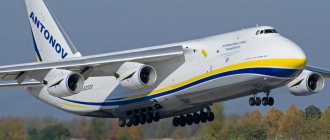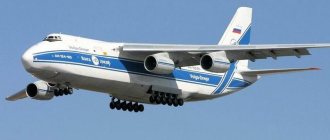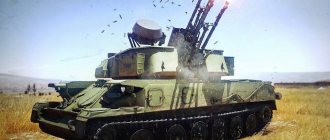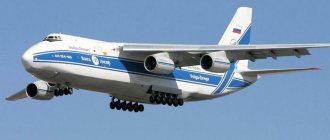History of creation
By the mid-70s of the twentieth century, the missile arms race between the USA and the USSR acquired the character of a fencing match. Each side, having tested a new powerful and long-range missile, sought to inject as painfully as possible, and into the most unprotected place of the enemy.
Such an unprotected place in the field of Soviet rocket science was the issue of transporting over long distances non-standard dimensions of silo and mobile intercontinental missiles. The fleet of heavy wide-body aircraft operated by the army did not meet completely new tactical and technical requirements. It was necessary not to reconstruct old aircraft, but to design and build completely new models capable of significantly increasing the tonnage and dimensions of transported cargo.
This model was the transport aircraft project developed at the Antonov Design Bureau - the An-124 (or Condor according to NATO classification). The first flight tests of the transport aircraft took place at the airfield in Gostomel near Kiev at the end of December 1982.
In total, the Kyiv Aviation Plant produced 55 aircraft and one test prototype over 20 years.
Design Bureau named after. O.K. Antonov designed several modifications of the base aircraft:
- Product “400” is the basic version, which was used for testing and fine-tuning the first production sample.
- An-124 is the first modification of a military transport aircraft.
- An-124-100 is a variant of the aircraft used for commercial purposes. For this purpose, partial dismantling of military equipment was carried out.
- An-124-100M - the aircraft's radio-electronic equipment has been modified, and the crew size has been reduced from six to four people.
- An-124-100M-150 is a variant with maximum payload capacity (up to 150 tons) and flight range (up to 5400 km).
Watch the video of the largest transport aircraft An-124:
Exploitation
The only copy of the An-225 aircraft received the Soviet tail number USSR-82060. After the collapse of the country and the transfer of the car to Ukraine, the number changed to UR-82060. In the spring of 1994, the flight prototype of the vehicle was mothballed (along with the second unfinished model).
The plane remained in this form until the summer of 2000, after which it was decided to return it to service. Some of the equipment on the An-225 was replaced and a number of new devices were installed to ensure flight safety.
Commercial flights began at the end of 2001. The machine is used by Antonov Airlines, a subsidiary of Antonov Design Bureau. The aircraft is chartered to transport unique large and heavy cargo over various distances.
Specifications
The very first test flights showed that the Antonov Design Bureau had designed and built a unique aircraft, which to this day no foreign heavy aircraft has been able to surpass in dozens of technical parameters.
This is confirmed by hundreds of aviation world records set by Ruslan at the most popular foreign aviation shows and during days of hard daily work.
The main modification of the aircraft was designed according to the following technical specifications:
- Number and composition of the crew - 8 2 pilots, navigator, 2 flight engineers, flight radio operator, 2 loading and unloading system operators;
- 7 – shift crew, 21 – service personnel. Depending on the modification and purpose of the aircraft, the crew composition may be changed.
Aircraft flight characteristics:
- maximum speed - 865 km/h, cruising speed - 800-850 km/h.
- flight range with a maximum load is 4800 km, with a load of 80 tons – 7500 km.
- practical ceiling – 11,600 m.
the aircraft landing gear is multi-supported and consists of 24 wheels. The An-124 is the only heavy transport aircraft in the world capable of taking off and landing from unpaved airfields.
Carrying capacity, aircraft weight
The aircraft is designed to handle extreme loads.
A loaded An-124 weighs 178.4 tons. The maximum fuel mass in tanks located in the wings is 212.35 kg. In a cargo compartment with a length of 36.5 m, a width of 6.4 m and a height of 4.4 m and a total volume of 1050 cubic meters, Ruslan can transport by air a maximum load of 120 tons. Two identical cargo hatches - rear and front, have a length of 6.4 m and a height of 4.4 m.
The take-off weight of a fully loaded and refueled aircraft is enormous - 392 tons. Only one aircraft exceeded the weight and size parameters of the Ruslan - the An-225 Mriya, designed on its basis.
Design
The all-metal fuselage of the An-124 aircraft is made according to the standard design for army transport vehicles with an upper swept wing. The tail unit is built according to a single-fin design. Composite materials were used in the manufacture of the fuselage and wing load-bearing kit.
The total weight of materials in the structure is 5000 kg.
Using this solution made it possible to reduce the weight of the empty machine by 2000 kg. The power structure of the fuselage is made up of transverse frames connected by longitudinal stringers and spars. The design uses working skin, which further increases the strength of the fuselage.
The 28⁰ swept wing has a high aspect ratio and a thick profile. The An-124 wing structure has four spars, the consoles are one-piece. The wing consists of three segments - nose, caisson and rear. The caisson is part of the aircraft's load-bearing structure and has a longitudinal and transverse strength set.
The mechanization of the control units consists of six sections of slats, which are installed along the nose of the wing along the entire span. At the rear of each console there is an internal flap and two additional sections of slotted flaps. Next to the flaps there are two ailerons and 12 sections of brake flaps.
The vertical tail of the An-124 aircraft consists of a fin and a rudder mounted on it. The steering wheel is divided into upper and lower sections. The keel is built according to a design with two spars and working skin. Horizontal stabilizers are made according to a similar design. The elevators, located on the rear of the stabilizer, consist of two elements - internal and external.
The An-124 fuselage has a profile in the form of two circles intersecting in the form of the number “8”, and is equipped with two decks inside. The radius of the upper circle is 1900 mm, the bottom – 3800 mm. The load-bearing frame and the casing are connected by welding and glue.
Some of the fuselage elements are made of carbon fiber, in particular the rear cargo hatch flaps.
Transverse sealed bulkheads divide the An-124 fuselage into several compartments. Sealing protects the underfloor compartments of the fuselage from flooding with rainwater and from the ingress of aggressive liquids (during transportation). The fuselage is equipped with a system of drainage holes to prevent fluid stagnation and corrosion. The upper front part is used to accommodate crew members (main and replacement).
Each An-124 crew consists of 6 people:
- crew commander;
- assistant commander;
- navigator;
- senior onboard engineer;
- flight engineer;
- radio station operator.
In addition to the personnel, the replacement crew compartment houses various flight equipment and life support systems. The equipment allows landing troops and delivering cargo at different times of the day under different meteorological conditions, as well as when countering enemy air defense systems.
The An-124 equipment includes a flight system with sighting and navigation units, a radio communication system, and special equipment for landing.
The An-124 cockpit is equipped with glazing attached to the cockpit frame. The replacement crew compartment has three round glazed windows facing to the side. Additional windows are made in the cargo compartment. They are designed to visually monitor the condition of engines and cargo compartment doors.
In the lower front part of the fuselage there is a cargo compartment adapted to accommodate military equipment.
The compartment runs along the entire length of the fuselage and is equipped with cargo hatches located in the forward and aft parts of the fuselage. The hatch openings are equipped with reinforcements. The useful volume of the compartment is 1050 m³. For loading and unloading, the An-124 aircraft is equipped with standard crane and mooring equipment.
The compartment contains two mobile cranes with a lifting capacity of 10 tons. Bridge-type units move on rails installed along the sides. Additionally, electric winches are installed, developing a traction force of up to 4500 kg. The lower deck equipment allows for the transportation of single cargo weighing up to 50 tons.
The section of the upper deck, located in the rear section, is intended to accommodate maintenance and accompanying personnel. The An-124 aircraft could accommodate up to 22 passengers. In most cases, the maintenance team consisted of two operators operating standard overhead cranes.
The personnel cabin is equipped with a pressure support system that allows flights at altitudes up to 8000 m without the use of oxygen masks.
The chassis is equipped with twelve supports. Of these, two are located at the front, and ten are located on the sides of the fuselage (five per side). All racks have two wheels and are equipped with individual independent suspension and a separate cleaning mechanism.
The front support does not have braking mechanisms, is equipped with a turning mechanism and allows the An-124 aircraft to turn on a runway 50 meters wide.
In this case, an asymmetric operating mode of the engines is used, which makes it possible to reduce the turning radius.
The landing gear doors of the An-124 are made of composite material to reduce weight. The main rack trolleys are equipped with a ground clearance adjustment system, which reduces the ramp inclination and simplifies loading and unloading. Structurally, the aircraft is designed for operation from runways longer than 3000 m, equipped with a concrete surface. In practice, the machines were successfully used from unpaved airfields.
The power plant includes four turbofan engines of the D-18T model. The installations were developed at the Zaporozhye design bureau "Progress" specifically for the An-124 and the even larger An-225 transport aircraft.
The engine is created according to a three-shaft design and consists of a compressor fan and two working rotors (low and high pressure). The design of the turbojet engine provides a high bypass ratio - up to 80%. The engines are located under the wing, on pylons. Additional TA-12 gas turbines are mounted in the chassis fairings.
The engine nacelles of the An-124 aircraft contain a pre-air preparation system for air conditioning systems in the cabins, as well as for the operation of the anti-icing system. Air is taken from the compressor, then it is cooled and supplied to the actuators under normal pressure.
The hydraulics of the An-124 aircraft operate from pumping units located on the engines. The units consist of two separate pumps.
Each system is autonomous and can provide fluid to all actuators.
Hydraulics operate the rudder system for controlling the aircraft, the extension and retraction of the landing gear, the flap drives, the braking and wheel control system, and the cargo hatch drives.
The electrical network of the An-124 is designed for alternating voltages of 115 and 200 V. The generating sets are located on turbofan engines and have a total power of 240 kVA. The fuel supply is located in the center section caissons.
There are 13 separate fuel tanks divided into 4 output stages. Gradual development allows you to maintain the alignment of the aircraft. The weight of fuel in tanks is up to 213 thousand kg.
Comparison of Mriya and Ruslan aircraft
The An-225 Mriya is a 2-keel transport aircraft designed on the basis of the Ruslan, but significantly superior to it in a number of technical characteristics.
"Mriya" has more than "Ruslan":
- The wingspan is 14.9 m.
- The wing area is 277 square meters.
- The empty weight of the aircraft is 71.6 tons.
- Maximum take-off weight – 248 tons.
- Fuel weight – 81.65 tons.
- The length of the cargo compartment is 7.5 m.
With comparable characteristics of the power plant, equipped with the same D-18T engines, the transport and operational parameters of the An-225 significantly exceed those of the An-124.
Mriya was created as the main transportation element of the Soviet space shuttle Buran.
An-124 (Ruslan)
Records and interesting facts
Over the years of operation, Ruslan entered its name into the Book of World Aviation Records more than 30 times:
- The record for lifting cargo into the air was set by an An-124 aircraft on July 26, 1985. "Ruslan" lifted a commercial cargo weighing 171.219 tons to a height of 10.75 km.
- achievements in the range of non-stop flights culminated in a unique record - without refueling, the aircraft flew 20,151 km in 25 hours 30 minutes.
- records for transporting the largest consignment of goods in one flight, transporting the heaviest air cargo and many others.
Dozens of commercial orders completed by Ruslans did not set records, but they amaze the imagination with the variety and weight and size characteristics of the cargo transported.
In the belly of the giant, mining dump trucks and hydraulic turbines, giant Egyptian antiquities and military fighters made flights.
“Ruslans” had to transport such exclusive cargo as gold and currency, concert equipment of the legendary rock band Pink Floyd and anti-aircraft missile systems.
Advantages of AN-225
When it was ready, there was no longer any need to transport parts of the Buran. Only once did he transport it for the Paris Air Show in 1989 .
With a short period of its use, it managed to achieve a number of significant records. For example, he transported the largest amount of cargo in the entire history of aviation - almost 157 tons.
In 2009, he was included in the Guinness Book of Records, as he was able to transport a monocargo with a total weight of 188 tons .
In general, this model has almost 250 different records around the world. The aircraft had a number of significant advantages.
Reconstruction of AN-225.
- First of all, the ability to transport large loads with a total weight of 250 tons . For example, 50 cars in one flight or turbines and generators.
- Secondly, it is the transportation of cargo up to 200 tons during intracontinental flights , without transfers. And for intercontinental ones - up to 150 tons .
- Thirdly, on the outside of the fuselage there is the possibility of attaching various cargoes up to 200 tons .
Disaster in Irkutsk
Over the entire period of operation of the An-124 aircraft, 4 aircraft were lost as a result of flight accidents.
One of the most difficult was the fall of a military aircraft in the sky over Irkutsk. Tail number RA-82005 first flew in October 1985. The total flight time of the aircraft at the end of 1997 was 1034 hours, or 576 take-off-landing cycles.
On December 6, 1997, one of the worst flight accidents in the history of military transport aviation occurred. Aircraft RA-82005 was flying from Moscow to the Vietnamese military airfield of Cam Ranh with landings in Irkutsk and Vladivostok. On board were 40 tons of cargo - two SU-27UBT fighters assembled at the Irkutsk Aviation Plant, 15 passengers and 8 crew members.
At 14:42 the plane took off from the Irkutsk airfield.
The further chronology of events was restored with scrupulous accuracy by specialists from the commission to investigate the causes of the disaster:
- 3 seconds after takeoff, height 5 m - surge and shutdown of engine No. 3.
- 9 seconds after takeoff, altitude 22 m - normal stop of engine No. 2.
- 11 seconds after takeoff, altitude 66 m – surge of engine No. 1.
The increase in angular velocity and angle of attack did not exceed the permissible values, but due to a sharp loss of thrust after stopping three of the four engines, the An-124 began to roll to the left and sharply decline with a simultaneous loss of linear speed.
The crew was unable to stabilize and keep the plane in flight with one working engine.
A giant plane fell 1.6 km from the Irkutsk-2 airfield on the city's Aviastroitel microdistrict. The main blow fell on house No. 45 on the street. Civil. The keel of the plane hit the wall of house No. 120 on Mira Street, and other large debris hit the building of an orphanage.
The total number of deaths in the plane crash is 72 people:
- 49 of them were victims of a catastrophe on earth, residents of Irkutsk, 15 of them were children.;
- 15 — Ruslan passengers;
- 8 - crew members.
70 families lost their homes. Hundreds of military and civilian specialists and equipment from the rescue center of the Russian Ministry of Emergency Situations took part in eliminating the consequences of the disaster.
An investigation conducted by a state commission named the official cause of the plane crash as the failure of 3 of the 4 engines in the power plant.
The situation was complicated by the fact that the on-board recorders of crew conversations and technical parameters of the aircraft were very badly damaged in the fire. Privately, after the completion of the official investigation, interviews appeared in which military and civilian experts and specialists expressed different points of view regarding the reasons for the failure of the Ruslan engines after takeoff.
The facts given below are unofficial and cannot be used as conclusions about the degree of culpability of the manufacturer, crew or technical personnel:
- reloading the aircraft before departure from the Irkutsk airfield.
- disruption of the operation of one of the on-board systems due to the use of prohibited electronic devices by one of the passengers.
- Exceeding the amount of 9 water in aviation kerosene and, as a result, the appearance of ice and failure of fuel filters of turbojet engines.
In 1999, at the site of the fall of “Ruslan” in Irkutsk, the Church of the Nativity of Christ was consecrated, erected in memory of the victims of the terrible disaster.











